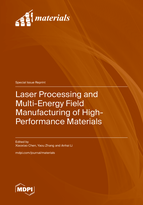Laser Processing and Multi-Energy Field Manufacturing of High-Performance Materials
A special issue of Materials (ISSN 1996-1944). This special issue belongs to the section "Manufacturing Processes and Systems".
Deadline for manuscript submissions: closed (31 August 2023) | Viewed by 27484
Special Issue Editors
Interests: laser polishing; laser milling; laser processing; digital manufacturing; beam modulation; multi-energy field manufacturing; hybrid machining; five-axis machining; surface quality
Special Issues, Collections and Topics in MDPI journals
Interests: electric discharge machining; special processing technology; multi-energy field manufacturing; digital manufacturing; smart manufacturing; movement control of electromechanical systems and special robots
Special Issues, Collections and Topics in MDPI journals
Interests: high-efficiency and precision machining; cutting tools; machined surface integrity; muti-scale and multi-physics modelling; cutting simulation
Special Issues, Collections and Topics in MDPI journals
Special Issue Information
Dear Colleagues,
The laser is a major invention of the 20th century, along with atomic energy, the computer and semiconductors. Laser processing technology is non-contact, which is suitable for the processing and manufacturing of various materials without cutting forces. During the machining process, the macro-/microprocessing of the mechanical motion and high-speed scanning of galvanometers can be realized. Compared with traditional processing, it has significant advantages in some aspects.
Today, with the development of materials science and technology, various new materials are emerging in an endless stream. People's technical demand for material applications is constantly increasing, and advanced materials have been widely used in various fields. At the same time, composite processing technology is also gradually developing. The composite manufacturing of multiple energy fields can benefit from the advantages of various single energies. After the optimization of various energy field combinations, the high-performance processing of materials can be achieved.
This Special Issue will summarize recent advances in the fields of laser processing and multi-energy field composite manufacturing. Articles published in this Special Issue will cover a variety of topics including, but not limited to, laser processing, special processing technology, high speed cutting, digital manufacturing, beam modulation, multi-energy field manufacturing, hybrid machining, five-axis machining, and surface quality. This Special Issue aims to showcase the latest achievements in the fields of laser processing and multi-energy field composite manufacturing, solicit the most important discoveries, highlight the challenges of processing mechanisms, theories and technologies, and provide an outlook on future directions.
Dr. Xiaoxiao Chen
Dr. Ya'ou Zhang
Dr. Anhai Li
Guest Editors
Manuscript Submission Information
Manuscripts should be submitted online at www.mdpi.com by registering and logging in to this website. Once you are registered, click here to go to the submission form. Manuscripts can be submitted until the deadline. All submissions that pass pre-check are peer-reviewed. Accepted papers will be published continuously in the journal (as soon as accepted) and will be listed together on the special issue website. Research articles, review articles as well as short communications are invited. For planned papers, a title and short abstract (about 100 words) can be sent to the Editorial Office for announcement on this website.
Submitted manuscripts should not have been published previously, nor be under consideration for publication elsewhere (except conference proceedings papers). All manuscripts are thoroughly refereed through a single-blind peer-review process. A guide for authors and other relevant information for submission of manuscripts is available on the Instructions for Authors page. Materials is an international peer-reviewed open access semimonthly journal published by MDPI.
Please visit the Instructions for Authors page before submitting a manuscript. The Article Processing Charge (APC) for publication in this open access journal is 2600 CHF (Swiss Francs). Submitted papers should be well formatted and use good English. Authors may use MDPI's English editing service prior to publication or during author revisions.
Keywords
- laser processing
- special processing technology
- high-speed cutting
- digital manufacturing
- beam modulation
- multi-energy field manufacturing
- hybrid machining
- five-axis machining
- high-performance materials
- surface quality
Benefits of Publishing in a Special Issue
- Ease of navigation: Grouping papers by topic helps scholars navigate broad scope journals more efficiently.
- Greater discoverability: Special Issues support the reach and impact of scientific research. Articles in Special Issues are more discoverable and cited more frequently.
- Expansion of research network: Special Issues facilitate connections among authors, fostering scientific collaborations.
- External promotion: Articles in Special Issues are often promoted through the journal's social media, increasing their visibility.
- Reprint: MDPI Books provides the opportunity to republish successful Special Issues in book format, both online and in print.
Further information on MDPI's Special Issue policies can be found here.









